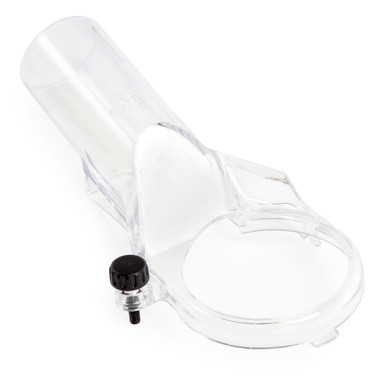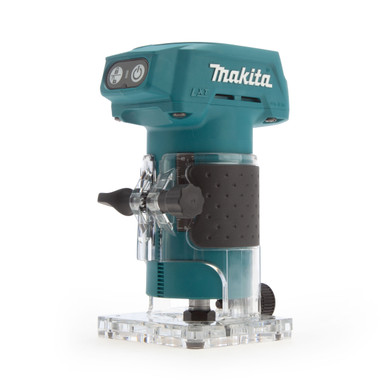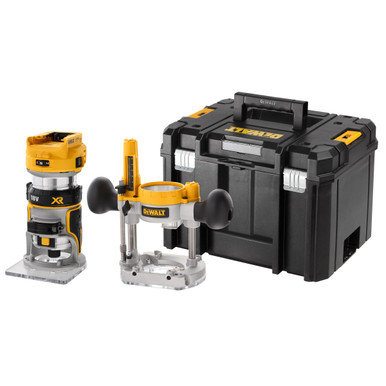How to Use a Router
Posted by Katy | Toolstop on 2nd Mar 2021
Routers are extremely versatile and handy tools, yet they can be daunting. This Toolstop blog shows you how to use a router, how to set up a router and all the different types of router cutter bits available on the market and their uses.
What is a Router?
Routers are a type of power tool most often used in joinery, woodworking and carpentry applications to undertake jobs such as cabinet and furniture making. Though most commonly used for woodworking, they can also be used in plastic and some other softer materials.
In this blog post we'll cover:
What does a router do?
A router works by spinning at speed to shape, cut and trim wood to create perfectly finished edges and corners. Routing a workpiece enhances its overall design.
They are most commonly used to create patterns in wood, such as round off worktop edges, add detailing to picture frames and cabinetry and so much more. By doing so, they take plain wooden edges to the next level.
But believe it or not, wood routers do more than just shape and cut wood. You can create dadoes, rabbets and more, all of which will be explained in this Toolstop blog.
How To Use a Router: Step By Step
Step 1: Fit your router bit by turning the tool upside down, making sure it's off first
Step 2: Adjust your router depth according to the type of router and task you are carrying out
Step 3: If using a variable speed router, set the correct speed for the application
Step 4: Connect to a Dust Extractor if you are able to
Step 5: Start cutting in the opposite direction that the router cutter is spinning for a smoother process
Step 6: For hand held routers, feed left to right
Step 7: For router tables, feed right to left
Setting Up & Using a Router
First we will talk you through how to set up and use a router, then we will go through some common router cutter bits and what they are used for.
Routers come fitted with a collet, either 1/2" or 1/4". This will determine the size shank router cutters you can use with it. When buying router bits, make sure you pick the correct shank size to fit your router collet. We recommend 1/2" routers, as they almost always come with a 1/4" collet, too, allowing you the option to use both. Router bits with a 1/2" shank tend to flutter less as the collet can grip to the shank better, resulting in an overall smoother cut.
To fit a router bit, first make sure your router is switched off. Turn the machine upside down, loosen the collet (you may need to use a spanner), insert your router bit of choice, then tighten the collet back up to hold the bit securely in place.
How to set the Depth on a Router
Adjusting the router depth allows you to control how deeply it will cut into the material and how much material is removed. This process can vary depending on the make and model of router, though is relatively easy and will be explained in your manual. To adjust the router depth on a plunge router, simply use the depth stop scale to adjust the tool to the desired depth for your chosen cut. Fixed base routers remain at a constant set height throughout the cut. They are simply adjusted using the trimmer base. Find out more about fixed base routers in our blog.
*If you are using a hand held router, the depth is how far below the base plate it will cut. If you are using your router with a router table, the depth is how far above the surface of the table top it will protrude.
How to use a wood router
If you are using a variable speed router, the next step is to set it to the correct speed for the application. This can be found in the instruction manual. Then you can connect it up to your dust extractor if it has this functionality. Routing can create a lot of dust, so this is always recommended if you are going to be routing often. You are now ready to power up and start routing.
Router bits spin in a clockwise direction, so when routing the top of a workpiece, it's recommended to go in an anti-clockwise direction. This way, the router is coming towards you, giving you better precision and control. Although, with this method, there is a tendency for the wood to chip. Should this happen, revert to a clockwise direction for a few inches. For edges, move the router in the opposite way that the bit is spinning (see below).
For hand held routers, feed left to right
For router tables, feed right to left
You always want to travel in the opposite direction that the cutter is spinning. This will ensure a smoother process, allowing the bit to glide with ease which will, in turn, provide you with the neatest results.
If you are new to using a router, you can always practice on scrap wood first. Most routers come with a parallel guide which is essential for ensuring the exact straightness of plunge cuts.
What Router Bit to use
There are so many different types of router bits and cutters on the market. The key to clean routed edges is to use a sharp, high quality router bit. At Toolstop, we have a huge selection of router bits and cutters for all uses.
Below we have listed some of the most common router bits and their uses. You can also refer to the diagram for a visual representation of the sort of cuts you can expect from these router bits.
Router bit types:
Straight Router Bits - One of the most commonly used types of router bits. They make straight cuts right into the material to hollow it out in order to create grooves or dadoes. Other popular uses of straight router cutters is for engraving letters, numbers or other shapes into wood. To make straight cuts, this is where your parallel guide will come in. If you want to engrave, simply sketch out your object, letter or number onto the wood and use your router to follow.
Rabbeting Bits - At Toolstop, we tend to refer to rabbet router bits as 'RB Router Bits', so look out for this in our product titles. Rabbeting bits can create straight, vertical and horizontal cuts. They aren't specifically used to create intricate designs to finish off wood, but more to create inlays for something else to lie in, for instance on picture frames, a rabbet cut will be used so that the glass can sit flush into the frame.
Flush Trim Router Bits - These router bits are used to trim the edge of one material flushly with another. For example if you needed to glue two bits of wood together, flush trim router bits will ensure that they have an exact edge and meet up exactly. This method is commonly used in veneered surfaces.
Chamfer Router Bits - Another extremely common router bit is the chamfer router bit. These router cutters create bevel edges at a specific angle depending on the bit and can also be used to transform the edge of your work piece.
Round Over Router Bits - These bits are similar to chamfer router bits, though can be used for much more intricate designs. These router bits are what allow you to create decorative and stylish edges on a material, really giving your creation that wow factor. They come in a variety of different styles to help you achieve different edges, including cove router bits and round over bits.
This is only to name a few of the extensive range of router bits available on the market. You can shop all these types and more at Toolstop.
Top Tip - When surface routing (cutting shapes into the face of a material), if you aren't cutting the full way across, e.g. for dado cuts, you can use a stop lock to ensure you only go to the exact length necessary.
We have attached a quick video demo on the Makita RT0700 Router, where we are shown how to make edging on a piece of wood.
Once you have the correct bit fitted to your router, it's as simple as that. Power up your machine and you're good to go. Remember, you can always practice on some scrap wood before attempting the real thing.
Routing will well and truly take your projects to the next level. Not only are they used in professional carpentry and woodworking applications, they are used and loved by DIY hobbyists alike. Shop our range of routers available at Toolstop and get routing today!
There are loads of different styles of routers available. If you are unsure which one to opt for, you can refer to our guides on why you should use a fixed based router or what to look for in a Dewalt router for more information.









